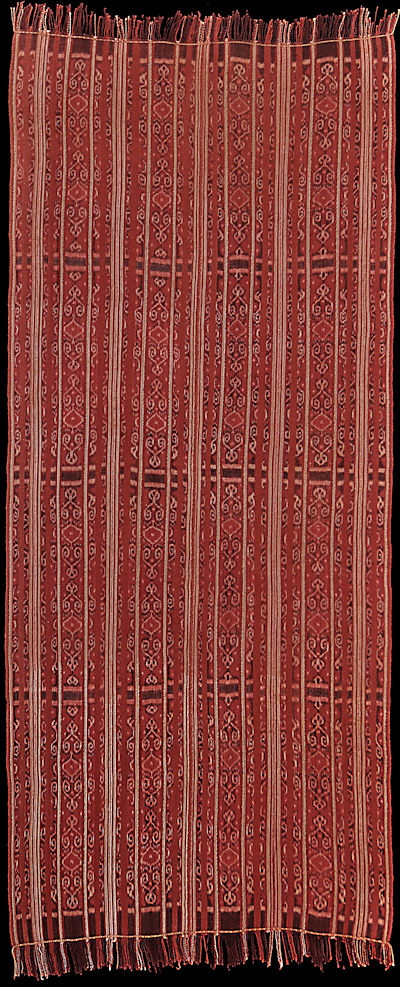| |
 
 | | | |
303 Timor, West Timor
Tais mane (men's wrap)  
| | Locale: | Probably Tamkesi village in southern Biboki, possibly Ponu in northern Biboki. | | Period: | 19th or early 20th c. | | Yarn: | Cotton, hand-spun, medium | | Technique: | Warp ikat | | Panels: | 2 | | Size: | 77 x 186 cm (2' 6" x 6' 1") LW: 2.42 | | Weight: | 635 g (22.4 oz), 443 g/m2 (1.45 oz/ft2) | | Design: | Patola-inspired biboeks'ana pattern, at the time the prerogative of royalty and the nobility. (In later decades, after independence, it came into wider use.) The motif is considered very powerful as it is associated with water sources essential for life. | | Comment: | Barrkman: 'The first royal biboeks'ana motif is claimed to have been made seven generations ago by the wife of the Neno Biboki ruler, suggesting the motif was created approximately 175 years ago (Taek Berek, pers. comm., 2004). At that time, foreign textiles traded into the region would have been accessible to the ruler’s wife, whose status enabled her to create new motifs. Interestingly, when an image of an Indian patola cloth with Motif X [model for Biboek'sa] was shown to the Biboki Kingdom's ceremonial house guardian, Paoespan’no, he saw it as a copy of his own kingdom’s royal Biboek’sa motif.' The piece is in excellent state of preservation. Microscopic inspection confirms the tactile impression of very densely woven cloth. The extremely brittle yarn, with filaments peeling off in all directions, points to advanced age. The fine white, ochre and pale blue pinstripes were also done in hand-spun yarn. Ex collection August Flick. | | Background: | Chapters on Timor and West Timor. | | Exhibited: | Timor: Totems and Tokens, Museu do Oriente, Lisbon, 2019/20. | | Published: | Timor: Totems and Tokens, 2019.
Ikat Textiles of Timor: Indonesian and Timor-Leste, 2025. | | Compare: | 176 177 216 370 | | Sources: | See Barrkman, Indian Patola and Trade Cloth Influence on the Textiles of the Atoin Meto People of West Timor, identifying the motif as imitation of patola. Cf. also PC 176, 177. More elaboration on the theme in Ruth Barnes's contribution to Hamilton and Barrkman, Textiles of Timor, p. 105-108; close-up of the motif, Fig. 6.14. Same motif on Balinese mordant print in Bühler and Fischer, The Patola of Gujarat, Fig. 73. Same motif on sarong in Honolulu Museum of Art, Acc. 10036.1. There is a clear similarity in both design and colour palette to the 19th c. sarong shown in Granucci, The Art of the Lesser Sundas, Fig. 120 (a younger version of PC 183). This cloth is also similar to our younger PC 176 and, to a somewhat lesser extent, 177. Pierre Dugard collected a similar piece, but with a white central panel, in Tamkesi. Similar tonality and motifs of the same 'family' are seen on a sarong in the Sweetbriar Collection, California. | | |

©Peter ten Hoopen, 2024
All rights reserved.
|
|


